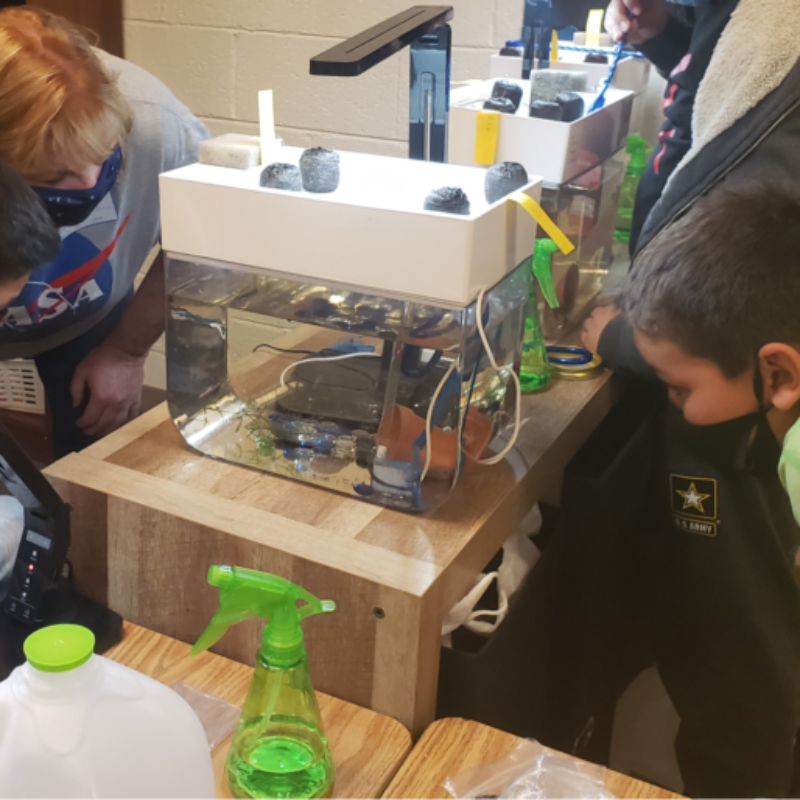“The aim of art is not to represent the outward appearance of things, but their inward significance.” — Aristotle
TweetComplimentary Content
Table of contents
Introduction
In today’s world, where rapid technological advancements shape our daily lives, the conversation around STEM vs. STEAM education is more relevant than ever.
To help educators navigate this evolving landscape, we’ll explore two prominent educational approaches: STEM (Science, Technology, Engineering, and Mathematics) and STEAM (Science, Technology, Engineering, Arts, and Mathematics).
Toward the end, we’ll also introduce our IFIZ (Indoor Farming Innovation Zone) program, which brings STEAM into the world of aquaponics, offering a unique and engaging way to inspire students.
But first, let’s delve into the nuances of STEM vs. STEAM education, exploring their benefits, limitations, and practical implementation strategies.
Understanding STEM Education
STEM education focuses on integrating science, technology, engineering, and mathematics to foster problem-solving and critical thinking skills. It emphasizes hands-on learning, encouraging students to apply theoretical knowledge to real-world challenges.
STEM education is often project-based, allowing students to experiment, build, and create while developing valuable technical skills.
Benefits of STEM Education:
- Strong Foundation in High-Demand Fields: STEM equips students with skills essential for careers in science, technology, engineering, and mathematics, which are among the fastest-growing sectors worldwide.
- Structured Approach: STEM’s project-based learning fosters analytical thinking and logical problem-solving, providing a clear framework for tackling complex challenges.
- Encourages Innovation: STEM promotes creativity and inventiveness, challenging students to think outside the box and develop innovative solutions.

Understanding STEAM Education
STEAM education builds upon the foundation of STEM by incorporating the arts—a key distinction in the “STEM vs. STEAM education” discussion.
This addition infuses creativity, design thinking, and emotional intelligence into the learning process.
STEAM recognizes that innovation often arises from the intersection of technical expertise and artistic expression.
Benefits of STEAM Education:
- Holistic Development: STEAM fosters well-rounded individuals by nurturing both analytical and creative skills, preparing students for a wider range of careers and life pursuits.
- Enhanced Engagement: Art can make STEM subjects more accessible and enjoyable, sparking curiosity and a love for learning.
- Empathy and Emotional Intelligence: Through artistic endeavors, students develop empathy, communication skills, and a deeper understanding of diverse perspectives.
STEM vs. STEAM: Key Differences
While both STEM and STEAM education aim to equip students with essential skills, the “A” in STEAM—representing the arts—creates some key distinctions. This integration of creativity and design thinking adds a unique dimension to the learning experience.
- Core Focus: STEM emphasizes technical skills and analytical thinking, while STEAM adds a layer of creativity, design, and emotional depth.
- Primary Skills Developed: STEM prioritizes problem-solving, critical thinking, and technical mastery. STEAM fosters these skills alongside creativity, empathy, and innovation.
- Curriculum: STEM curricula are heavily project-based, focusing on technical fields. STEAM adds artistic and design projects to enrich the learning experience.
- Career Pathways: STEM primarily prepares students for STEM-related careers. STEAM broadens career options to include fields like design, digital media, and the arts.

Implementing STEM and STEAM in the Classroom
Whether you choose STEM, STEAM, or a blend of both, effective implementation requires thoughtful planning and adaptability. Here are some key strategies:
- Define Learning Goals: Clearly identify the skills, knowledge, and overall learning outcomes you want your students to achieve.
- Incorporate Project-Based Learning: Engage students with real-world problems that require them to apply STEM or STEAM concepts in a meaningful context.
- Utilize Technology and Resources: Leverage technology tools like coding platforms, 3D printing, and simulation software to enhance learning experiences.
- Encourage Collaboration and Communication: Foster teamwork and communication skills through group projects and collaborative activities.
- Assessment and Reflection: Assess student learning based on project outcomes, creativity, technical proficiency, and collaborative skills. Encourage reflection to promote critical thinking and self-evaluation.

IFIZ: A Real-World Example of STEAM in Action
Our Indoor Farming Innovation Zone (IFIZ) program exemplifies the power of STEAM education.
IFIZ introduces students to aquaponics, a sustainable farming method that combines raising fish with growing plants.
Through a STEAM-focused curriculum, students explore the science behind aquaponics while also engaging in design thinking and creative problem-solving.
Conclusion: Empowering Students for the Future
Both STEM and STEAM offer valuable frameworks for preparing students for a rapidly changing world.
The goal of both STEM vs. STEAM education is to empower students to become innovative problem-solvers, critical thinkers, and engaged, lifelong learners.
STEM provides a strong foundation in technical skills, while STEAM adds a layer of creativity and adaptability.
Whether you choose STEM, STEAM, or a blend of both, the key is to create a dynamic and engaging learning environment that fosters curiosity, collaboration, and a passion for discovery. This is the true value of both STEM vs STEAM education.
FAQs
STEM focuses on Science, Technology, Engineering, and Math. STEAM includes Art, adding a creative aspect to technical education.
Why is art included in STEAM?
Art in STEAM encourages creative thinking, adaptability, and emotional intelligence, all valuable skills in problem-solving.
Which is better for future careers: STEM or STEAM?
Both are valuable, but STEAM may provide an edge by combining creativity with technical skills, which employers highly value.
How can teachers implement STEAM in classrooms?
Teachers can introduce real-world problems, encourage collaboration, and integrate technology and design into STEM subjects.
What is the IFIZ program?
IFIZ is an indoor farming program teaching aquaponics through a STEAM-focused approach, blending science and creativity for a hands-on learning experience.
The I Will Projects, a 501c3 Non-Profit, promotes diverse solutions for global challenges. Our IFIZ education programs, emphasizing aquaponics, and insect farming, empower communities through knowledge, collaboration, and sustainable innovation.













